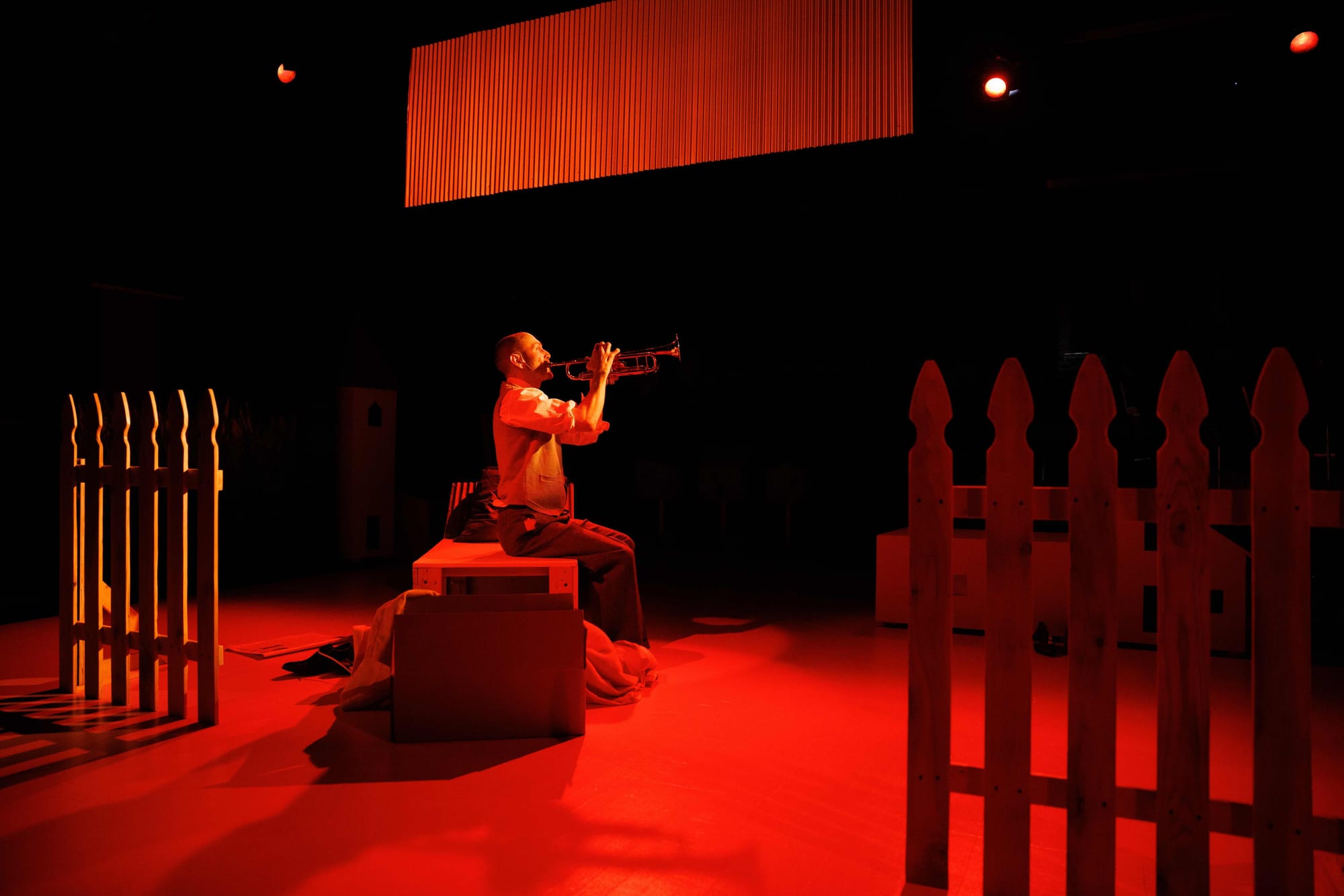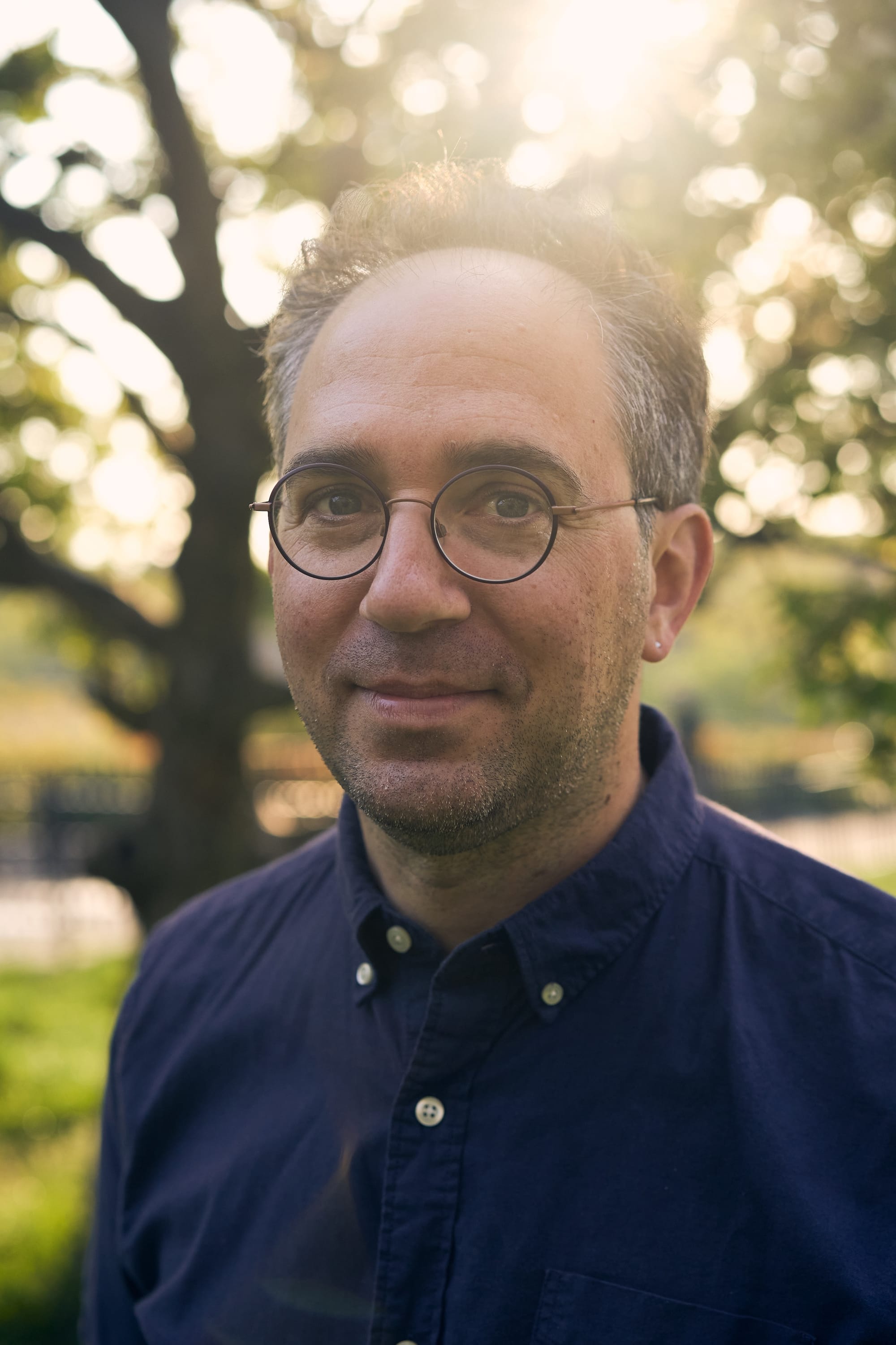A man is pronounced dead, and then he wakes up in the morgue. That is the event which sets composer Aaron Siegel's opera Rainbird in motion. Rainbird is an adaptation of the novel Yellow Flowers in the Antipodean Room by the celebrated New Zealand author Janet Frame. Siegel worked collaboratively with cross-disciplinary director and creator Mallory Catlett to assemble a libretto using language directly from Frame's book. The opera has had a series of workshops and excerpt performances and from April 16-20 had its opening run at Mabou Mines in New York. Rainbird was produced by Experiments in Opera, a NYC-based artist-led non-profit opera collective for which Siegel is the Co-Founder, Executive Director, and Composer.
I briefly spoke with Aaron Siegel about Rainbird in between tech-week moments for my SOLOpera The INcomplete Cosmicomics, which was produced by Experiments in Opera (EiO) on a double bill with a SOLOpera by Jason Cady last month. But tech-week is hardly the time to delve into details so the following is really an excuse for me to ask Aaron Siegel all of the questions that I wanted to upon taking a look at the Rainbird libretto/score. I will also forever be calling him by his first + last name because my production had three Aaron's/Erin's on deck...
Before EiO produced my opera I played viola in their production of Chunky in Heat (2019) and the workshop of Everything for Dawn (2020). I'm such a fan of their collaborative methods and want to mention that EiO launched a fundraising campaign today! They’re aiming to raise $25,000 by June 30, 2025 and every (tax deductible!) contribution will be matched by their generous board and founding funders.
Anna Heflin: You collaboratively “assembled” the libretto with librettist/director Mallory Catlett from New Zealand author Janet Frame’s own words. How did you and Catlett divide the responsibilities? What was the process of the libretto’s construction?
Aaron Siegel: Mallory and I both read the book and started talking about what scenes felt the most important to start out with. We were both eager from the beginning of the process to try and use as much of Frame’s language in the libretto as possible, so we made copies of pages of the book and cut and pasted passages into a collage. I used these cut-outs in the first drafts of some of the early scores. Working that way allowed me to think more visually about the musical scores, something I prefer to do, especially early in the process. Once we had a couple of scenes that we felt were working, I created notecards for each chapter in the book and we started to fiddle around with different structures and forms. Pretty quickly, we settled upon a narrative arc that had a three-act structure. We weren’t necessarily looking for three-acts, but I think it is a credit to the novel that Frame was very classical in her structure of this book. Each time we workshopped the piece, we would cut language that we felt wasn’t working or was a little anachronistic. The final libretto is a honed-down text, with all of the important information for the story, and not so much fluff. But we were able to stick to our original intention of having all of the language directly from the book itself.
AH: Rainbird has been an eight-year-long process for you with five residencies/excerpt showings in New York between 2018-2020. What edits did you make throughout the process? Did anything surprise you about how the work developed?
AS: The amazing thing about Frame’s language is that it is so carefully considered and potent. Each phrase has a depth to it that requires space and unpacking. Several of the scenes started with these potent images or ideas, ie. a lawnmower or an electric blanket or a phrase like ‘fair is fair,’ but then spun into much broader and more complicated scenes. The challenge for us during every workshop was to make sure we were finding the clearest and most concise way of presenting the language. Brevity is really important to me as a composer working with text. If there is too much text to set, I get overwhelmed and find that I can’t let my ear and imagination lead the way. At the same time, too little text doesn’t support a substantial scene or image, and can trip up a narrative flow. We would add language at various points, or take some away, and I had to make sure that the music I was writing could accommodate these changes. This is part of the reason that I ended up writing these longer looped sections that had the flexibility to adjust according to how many words the performers were singing. I should also say that there is a considerable amount of melodic and rhythmic improvising in the piece. So, depending on tempo and the feeling that the performers were trying to evoke, the text may be shorter or longer as the performance is happening. My challenge was to build in a certain amount of flexibility to the score, while also making sure to maintain its identity as a cohesive work.
AH: Looking at the libretto/score I’m noticing how the chorus functions as narrator, could you talk a bit about their role? What does it mean to have a group of people inside and outside of the story and how does that relate to the broader operatic tradition?
AS: The chorus in Rainbird came about because there was a need to bring in the community of the Dunedin, NZ setting. The Rainbird family is the core of the piece, but the community around them plays an important role in the Rainbirds’ fate. I appreciate the history of the chorus in opera as a way of creating spectacle and increasing the impact of a piece. Not to mention, choral writing can be quite a breath of fresh air after so much solo or small group singing. But in Rainbird, there was a key storytelling role for the chorus, too. The original novel wrestles with themes of otherness and immigration, and Godfrey Rainbird is an immigrant to New Zealand even before he dies, comes back to life and is an immigrant from death itself in some ways. As we all know too well in this country right now, the community of people in a town or area can really define how new people are accommodated (or not) to the environment and social customs. When, as is the case in Rainbird, the community decides that someone is not welcome, they can be quite cruel and decisive. The chorus in Rainbird brings this ‘community’ perspective to life.
AH: The keyboard part switches frequently between toy piano and electric organ – what is the significance of those instruments to you? Is the toy piano intended to stir up sentimentality, innocence, playfulness, something else entirely?
AS: The instrumentation for Rainbird really came together over time. As a creator of theater and long-form works, I really value the possibilities of different permutations of instruments. My teacher Alvin Lucier made a piece for wind quintet where each section of the longer piece was just different duos among all five instruments. I really liked this approach, in the sense that it gives a shape to the longer work, and also creates a sense of difference between sections. There is an emotional aspect to this too, if listeners can start to make the connections between different instruments and start to anticipate their co-existence. The toy piano does have a creepy and child-like quality about it, but it is also angelic, matches nicely with the glockenspiel and violin, and given its limited range, encourages economy. The organ is pretty much the opposite of the toy piano–long sustained tones, very little attack envelope and a much wider tessitura. There is a nice range of possibilities with a pairing like this.
AH: There are specific “Hold for improvisation” moments indicated in the score. What has the rehearsal process been like for those? Does anyone take the lead or is it an equal playing field?
AS: It has taken me a while to really understand how my love of improvisation can fit within my more heavily noted compositions, and especially in theater and opera, where there is often not enough time to really allow for this kind of exploration. Not to mention, most opera singers are not particularly well-trained improvisers. The key for Rainbird was the desire to have the recitative sections be looser and allow the singers to embody the dialogue in a more naturalistic way. I worked with all of the singers, Gelsey [Bell], Chris [DiMeglio], Shurmi [Dhar] and Katie [Geissinger], over years of collaboration to make the process work. Mostly, there is a lot of listening in rehearsals–listening to the harmonic and rhythmic information in the instruments, as well as probing the nature of the text. How are the characters talking with each other? What do they need to communicate, etc. My collaborator Mallory Catlett is brilliant as a leader of these kinds of explorations. And since Mallory likes to tinker up until the first show, the performers had ample time to keep exploring different musical and actorly approaches. They are still finding new material to sing every night. It’s pretty exciting to watch.

AH: Technical question – I don’t see a conductor listed in the credits. Is there a click track or is the keyboard player indicating cues?
AS: The piece was really written to be a chamber experience. I didn’t want a conductor onstage, I wanted the instrumentalists and the singers to be aware of each other and take cues and tempi from each other. Most of my music exists on the metric grid, meaning there is not a lot of rubato, or tempo variations within a section. This probably comes from my interest in jazz and other pulse-based musics, where the band creates the tempo and rhythmic logic of the music at any given moment. I also really value rhythmic flow and momentum, so I want to create music where performers can set up and then play around in a rhythmic feel. I find that musicians, once they relax into a rhythmic feel, start to open up their sound and their expressions in a vastly different way.

Aaron Siegel has worked as a musician, composer, organizer and educator for 25 years in New York City. In his world, there is little distinction between the activities of producing, writing, performing, listening, and learning. Celebrated as a composer of works for percussion (“hypnotic clouds of chiming tones” – The New Yorker) and the stage (“softly shattering” – NY Times), Siegel has a long history as an improvising percussionist and bandleader. Since 2011, Siegel has co-led the radical opera collective Experiments in Opera (“Raw, funny, surreal, and disarmingly human”- Opera News), helping to bring to the stage countless works by composers and writers and expanding the boundaries of musical storytelling. Always happy to explore in community with others, Siegel has created work with A.M. Homes, Mallory Catlett, Tracy K. Smith, Mantra Percussion, Anthony Braxton, Memorize the Sky, Anthony Roth Costanzo and the EiO Writers Room among others.
Siegel’s work has been performed at venues and festivals around the world and been featured on recordings for New Amsterdam Records, Gold Bolus Records, Peacock Recordings, Clean Feed Records, Broken Research, and Lockstep Records. He has been recognized with awards from the Foundation for Contemporary Art, Chamber Music America, the New York State Council for the Arts, New Music USA, Opera America, the Jerome Foundation, and the Aaron Copland Fund for Music among others.

